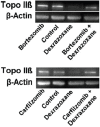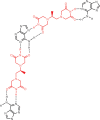The cardioprotective effect of dexrazoxane (Cardioxane) is consistent with sequestration of poly(ADP-ribose) by self-assembly and not depletion of topoisomerase 2B
- PMID: 30792806
- PMCID: PMC6351063
- DOI: 10.3332/ecancer.2018.889
The cardioprotective effect of dexrazoxane (Cardioxane) is consistent with sequestration of poly(ADP-ribose) by self-assembly and not depletion of topoisomerase 2B
Abstract
Following systematic scrutiny of the evidence in support of the hypothesis that the cardioprotective mechanism of action of dexrazoxane is mediated by a 'depletion' or 'downregulation' of Top2β protein levels in heart tissue, the author concludes that this hypothesis is untenable. In seeking to understand how dexrazoxane protects the heart, the outcomes of a customised association rule learning algorithm incorporating the use of antecedent surrogate variables (CEME, 2017 McCormack Pharma) reveal a previously unknown relationship between dexrazoxane and poly(ADP-ribose) (PAR) polymer. The author shows how this previously unknown relationship explains both acute and long-term cardioprotection in patients receiving anthracyclines. In addition, as a direct inhibitor of PAR dexrazoxane has access to the epigenome and this offers a new insight into protection by dexrazoxane against doxorubicin-induced late-onset damage [McCormack K, manuscript in preparation]. Notably, through this review article, the author illustrates the practical application of probing natural language text using an association rule learning algorithm for the discovery of new and interesting associations that, otherwise, would remain lost. Historically, the use of CEME enabled the first report of the capacity of a small molecule to catalyse the hybrid self-assembly of a nucleic acid biopolymer via canonical and non-canonical, non-covalent interactions analogous to Watson Crick and Hoogsteen base pairing, respectively.
Keywords: Watson Crick; anthracyclines; cardioprotection; dexrazoxane; epigenome; poly(ADP-ribose); topoisomerase 2β.
Figures
















Similar articles
-
Dexrazoxane : a review of its use for cardioprotection during anthracycline chemotherapy.Drugs. 2005;65(7):1005-24. doi: 10.2165/00003495-200565070-00008. Drugs. 2005. PMID: 15892593 Review.
-
Topoisomerase IIbeta mediated DNA double-strand breaks: implications in doxorubicin cardiotoxicity and prevention by dexrazoxane.Cancer Res. 2007 Sep 15;67(18):8839-46. doi: 10.1158/0008-5472.CAN-07-1649. Cancer Res. 2007. PMID: 17875725
-
Poly (ADP-ribose) polymerase pathway inhibitor (Olaparib) upregulates SERCA2a expression and attenuates doxorubicin-induced cardiomyopathy in mice.Environ Toxicol Pharmacol. 2023 Oct;103:104261. doi: 10.1016/j.etap.2023.104261. Epub 2023 Sep 7. Environ Toxicol Pharmacol. 2023. PMID: 37689219
-
A QSAR study that compares the ability of bisdioxopiperazine analogs of the doxorubicin cardioprotective agent dexrazoxane (ICRF-187) to protect myocytes with DNA topoisomerase II inhibition.Toxicol Appl Pharmacol. 2020 Jul 15;399:115038. doi: 10.1016/j.taap.2020.115038. Epub 2020 May 15. Toxicol Appl Pharmacol. 2020. PMID: 32417440
-
Dexrazoxane. A review of its use as a cardioprotective agent in patients receiving anthracycline-based chemotherapy.Drugs. 1998 Sep;56(3):385-403. doi: 10.2165/00003495-199856030-00009. Drugs. 1998. PMID: 9777314 Review.
Cited by
-
The Role of Mitochondrial Quality Control in Anthracycline-Induced Cardiotoxicity: From Bench to Bedside.Oxid Med Cell Longev. 2022 Sep 21;2022:3659278. doi: 10.1155/2022/3659278. eCollection 2022. Oxid Med Cell Longev. 2022. PMID: 36187332 Free PMC article. Review.
-
Mechanisms of Anthracycline-Induced Cardiotoxicity: Is Mitochondrial Dysfunction the Answer?Front Cardiovasc Med. 2020 Mar 12;7:35. doi: 10.3389/fcvm.2020.00035. eCollection 2020. Front Cardiovasc Med. 2020. PMID: 32226791 Free PMC article. Review.
-
Endothelial-to-Mesenchymal Transition: Potential Target of Doxorubicin-Induced Cardiotoxicity.Am J Cardiovasc Drugs. 2023 May;23(3):231-246. doi: 10.1007/s40256-023-00573-w. Epub 2023 Feb 26. Am J Cardiovasc Drugs. 2023. PMID: 36841924 Review.
References
-
- Yeh ETH. Topoisomerase 2b as a predictor of susceptibility to anthracycline-induced cardiotoxicity. United States Patent Application Publication Application Number 14/155,858 Publication Number US 2014/0200192 A1.
LinkOut - more resources
Full Text Sources
